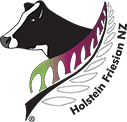The versatility of Holstein Friesians is being credited with allowing a young South Canterbury couple to produce zero bobby calves.
Ryan and Billie Moffat milk 460 cows at Waimate. Production on the 145-hectare irrigated property was 262,000 kilograms of milksolids (kgMS) in 2018-19.
The couple bought the farm off Ryan’s parents Mike and Chris Moffat last year, after buying their herd four years’ earlier.
“Our business doesn’t produce any bobby calves,” said Billie.
“We’ve always had a strong market for our surplus heifer and beef calves. That’s a huge benefit of farming Holstein Friesians.”
“There’s limited demand for bull calves out of Crossbred and Jersey cows.”
Six years ago, the Moffat’s started using Samen’s overseas genetics over their herd.
“We were quite a high BW (breeding worth) herd, with a big focus on BW. We used a lot of LIC genetics, then switched to using CRV Ambreed sires,” said Ryan.
“But the genetic pool was getting too tight and we wanted to breed a higher-producing, medium-sized Holstein Friesian cow.”
The Moffat’s are aiming for per cow production of 550 kgMS.
“We usually rear about 160 replacement heifer calves, selling 40 after weaning. They go to a local buyer or are sold to the export market,” said Billie.
“There’s still a big demand for the heifers. People are starting to look for quality over high BW. We have been really impressed with our Samen calves. Last spring’s calves are probably the best we’ve had.”
The couple is in their second season doing all artificial insemination (AI).
The main bulls they have been using are Seagull-Bay MVP-ET, ABS Joppolo PP-ET, Co-Op Bosside Massey-ET and DE-SU 11236 Balisto-ET.
“We use mainly Holstein Friesian sires. In the final four weeks of mating we mix it up a bit and use Angus, Speckled Park, Belgium Blue and Wagyu semen,” said Ryan.
Rising two-year-old heifers, which are at a 185-hectare (effective) runoff owned by Ryan’s parents nearby, are run with Angus bulls.
“Our beef calves have always been highly sought-after. Mum and Dad now buy our beef calves. They take them right through to finishing, where they’re worth around $2,000/head based on current prices,” he said.
“Here in the South Island we get between $100-$150 for four-day-old calves, which is significantly more than what a bobby calf is worth.”
The Moffat’s start calving on August 1st and milk through until the end of June.
Tackling the herd’s empty (not in calf) rate, which usually sits between 16-20 per cent, is currently their number one focus.
Ryan believes the herd’s high per-cow milk production is a contributing factor, with energy intakes failing to match outputs.
“Within weeks of calving our cows are producing well over 2 kgMS/day, and they’re peaking at an average of 2.7-2.8 kgMS. That is at a time when we are trying to get them to cycle and get in calf,” he said.
“I think historically they’ve probably been slightly energy deficient.”
This season, bypass fat has been added to the herd’s in-shed feed ration to help plug the energy gap.
“Bypass fat is high in energy content. It has an ME (metabolisable energy) of 33 per cent. It’s expensive, but so is having empty cows, so we hope it will make a difference to our final in-calf rate,” he said.
“It’s already had a positive impact. The cows had a much higher BCS (body condition score) at mating this year.”
The farm has a modern six-year-old 54-bale rotary milking shed with automated drafting.
The cows’ in-shed feed mix consists of barley, wheat, distillers’ grain, tapioca and proteins like canola. Minerals such as magnesium and calcium are added to molasses.
The farm does not have a feed pad. The next big infrastructure project on the horizon is expanding the irrigation system.
“We have one centre pivot that covers 65-hectares. There are a further 13-14 hectares under k-line irrigation. The remainder of the farm is under flood irrigation which will be converted to pivots over the next four years,” said Ryan.
“That side of the farm is an odd shape, so we might need several smaller pivots.”
The herd will be wintered on just grass and silage for the first time this year. Fodder beet is grown at the runoff for young stock and beef cattle.
The Moffat’s have 313 registered pedigree Holstein Friesians, including young stock, and are keen to grow the number.
“We stopped registering our cows through the pedigree system when we were developing the farm,” he said.
“It’s something we got back into this year. We’ve been using Holstein Friesian sires, so a lot of animals were eligible for registration.”
The Moffat’s trade under the name Deltop Dairy Limited. They featured heavily in the 2018-19 production results for registered Holstein Friesian cows.
They were the top producing protein herd in the Canterbury/Westland ward, with an average of 312 kg/cow (3.6%). They ranked 9th highest in the country.
The Moffat’s were second highest in their ward for fat, with an average of 337 kg/cow (3.9%).
Ryan and Billie have three children Olivia (10), Vincent (9) and Delilah (6).
The couple has two staff, Raymond Serilo and Jerome Paray, which make juggling young children and runoff easier.



Add a Comment
You must be logged in to post a comment